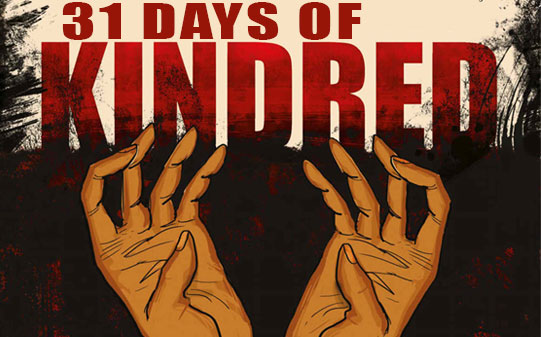The graphic novel adaptation of Octavia E. Butler’s Kindred that I wrote/lettered and John Jennings drew will be released by Abrams ComicArts on January 10, 2017 (available for pre-order now). In recognition of that momentous occasion, I’m writing 31 blog posts about the path from novel to graphic novel. This is 31 Days Of Kindred.
* * *
Day 12
Birth of a Discrimination
* * *
Did you know Octavia Butler originally intended for the protagonist of Kindred to be male? The novel was inspired by Butler overhearing a male classmate at Pasadena City College opine that, “I’d like to kill all these old people who have been holding us back for so long. But I can’t because I’d have to start with my own parents.” Butler understood that this man, “…felt so strongly ashamed of what the older generation had to do, without really putting it into the context of being necessary for not only their lives but his as well.” Butler implies in interviews that, since this classmate’s comment had given her the idea for the story, she originally wrote the protagonist as male.
I wanted to take a character, when I did Kindred, back in time to some of the things that our ancestors had to go through, and see if that character survived so very well with the knowledge of the present in her head. Actually, I began with a man as main character, but I couldn’t go on using the male main character, because I couldn’t realistically keep him alive. So many things that he did would have been likely to get him killed. […]The female main character, who might be equally dangerous, would not be perceived so. She might be beaten, she might be abused, but she probably wouldn’t be killed and that’s the way I wrote it. […]That sexism, in a sense, worked in her favor. Although if you could take the character and give her life and ask her if she thought she had been favored, it would be likely that she wouldn’t think so, because of what she suffered (Rowell, 1997, p. 51)
It’s disheartening, although unsurprising, how the view of black man as inherently dangerous, a prejudicial view that continues to resonate unabated in everything from racist language in conservative news media to the justifications for police shootings of unarmed African Americans. This prejudice is so ingrained in American history that even fiction cannot overcome the indelible white projections of fear onto black bodies (which is to say, just bodies, objectified, unrelated to the human inhabiting the body).
But it’s also interesting how, while Butler thought of institutional sexism as rescuing Dana from immediate death, she also writes Dana being mistaken for a man multiple times, usually because she’s wearing pants instead of a dress. Dana is often entangled in varying threads of sexism and racism, and not just in the eyes of white slave owners. In the 1970s, she’s estranged from her adoptive parents, her aunt and uncle, because they disapprove of her marrying a white man. In the 1800s she’s criticized by slaves on the Weylin plantation for talking “like a white person.”
The novel paints a picture of racism and sexism as overwhelming historical forces, inescapable and unrelenting. But it also presents possibilities for resistance, albeit with interminable battles, spanning generations, and victories rare and hard won. Like my discussion of literacy yesterday, I guess today is another example of how the truths of the novel grow only more poignant as time passes.
—
Rowell, C. H. & Butler, O. E. “An Interview with Octavia E. Butler.” Callaloo, vol. 20 no. 1, 1997, pp. 47-66. Project MUSE, doi:10.1353/cal.1997.0003.

